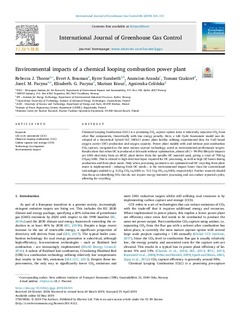Environmental impacts of a chemical looping combustion power plant
Thorne, Rebecca Jayne; Bouman, Evert; Sundseth, Kyrre; Sanchez, Maria Asuncion Aranda; Czakiert, Tomasz; Pacyna, Jozef M; Pacyna, Elisabeth G; Krauz, Mariusz; Celińska, Agnieszka
Peer reviewed, Journal article
Published version
Permanent lenke
http://hdl.handle.net/11250/2636544Utgivelsesdato
2019Metadata
Vis full innførselSamlinger
Originalversjon
International Journal of Greenhouse Gas Control. 2019, 86 101-111. 10.1016/j.ijggc.2019.04.011Sammendrag
Chemical Looping Combustion (CLC) is a promising CO2 capture option since it inherently separates CO2 from other flue components, theoretically with low energy penalty. Here, a Life Cycle Assessment model was developed of a theoretical hybrid CLC (HCLC) power plant facility utilising experimental data for CuO based oxygen carrier (OC) production and oxygen capacity. Power plant models with and without post-combustion CO2 capture, recognised as the most mature capture technology, acted as environmental performance targets. Results show that when OC is produced at lab-scale without optimisation, almost all (>99.9%) lifecycle impacts per kWh electricity from an HCLC plant derive from the specific OC material used, giving a total of ˜700 kg CO2eq/kWh. This is related to high electrical input required for OC processing, as well as high OC losses during production and from plant waste. Only when processing parameters are optimised and OC recycling from plant waste is implemented - reducing fresh OC needs – is the environmental impact lower than the conventional technologies studied (e.g. 0.2 kg CO2 eq/kWh vs. ˜0.3-1 kg CO2 eq/kWh, respectively). Further research should thus focus on identifying OCs that do not require energy intensive processing and can endure repeated cycles, allowing for recycling.
